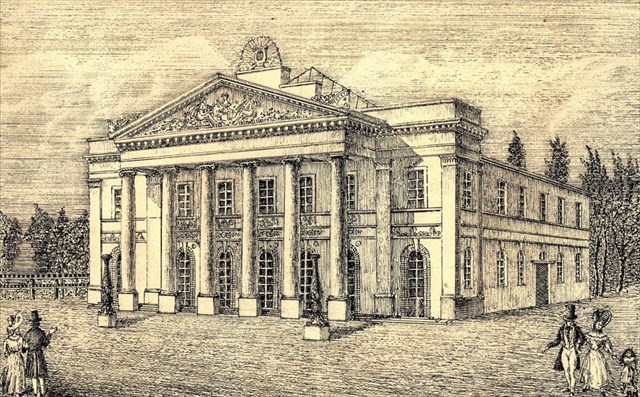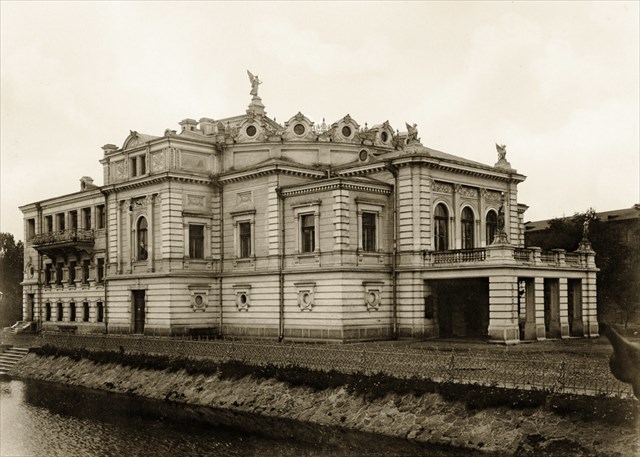Bogusławski w 3 aktach.
Akt 1.
Poznanie historii teatru to podróż. A więc przenieśmy się do roku 1800 kiedy to do małego, sennego Kalisza przyjeżdża trupa teatralna z Bogusławskim na czele. Bogusławski nie miał wielkich oczekiwań wobec Kalisza , liczył raczej na przybycie parunastu zapaleńców. Tym czasem 2 sierpnia w „nędznej budzie” przy ulicy Babina tłumnie zgromadzona publiczność oglądała między innymi słynnych „Krakowiaków i Górali”. Po miesiącu występów Dyrektor cieszył się już wielkim uznaniem. W 1801 roku Bogusławski przystąpił do budowy Pierwszego Teatru w Kaliszu. Budowa trwała 11 dni-w miejscu wspomnianej jako „nędzna buda”. Wnętrza i dekoracje stworzył malarz i dekorator Antoni Smuglewicz. Po 16 latach pierwszy kaliski teatr był już w opłakanym stanie i w 1817 roku został zburzony.
Bogusławski był postacią niezwykle znaczącą dla miejscowej społeczności. A i Kalisz stał się dla niego ważnym miejscem. Tutaj debiutowała w 1802 roku jego córka, Rozalia. Bogusławski uważał, że kaliska publiczność nie była tak surowa i wymagająca, jak w Warszawie. Niewątpliwie była to publiczność, która szczerze interesowała się sztuką. Aktywnie i z wielkim entuzjazmem wspierała działania artystyczne.

Akt 2.
Dążono do tego by w Kaliszu powstał nowy teatr. Jednak ciągle napotykano na nieprzychylności – albo władz albo żywiołów. W 1816 roku mieszkańcy podjęli pierwsze starania, by postawić teatr. Ale ten pomysł nie podobał się władzom miasta (wtedy już w Królestwie Polskim), które teatr uważały za niebezpieczny – artyści mogli tam przemycać hasła wolnościowe. Tymczasem trupa Osińskiego i inne zespoły teatralne, które przyjeżdżały do Kalisza, grały w Hotelu Polskim Ludwika Woelffla. Według władz to zupełnie wystarczało, by zaspokoić potrzeby kulturalne kaliszan. W 1829 roku Jakub Lubiejewski (woźny trybunału) stworzył nad brzegiem Prosny, tuż przy parku, scenę letnią. Zimą zaś zespoły nadal grały u Woelffla. W 1834 roku władze zdecydowały o odkupieniu teatru od Lubiejewskiego. Przeprowadzono generalny remont, a drewniany budynek zamienił się w nowoczesną, doskonale wyposażoną salę teatralną. W Kaliszu 11 września 1835 roku doszło do spotkania cara Mikołaja I i pruskiego króla Fryderyka Wilhelma III. Niedługo po zjeździe budynek zaczął stopniowo popadać w ruinę, a nie było zgody na jego odbudowę. Teatr, zniszczony przez dwie powodzie, spłonął 19 kwietnia 1858 roku. Na szczęście – bo znajdował się już w bardzo złym stanie, ale za to dobrze go ubezpieczono w Towarzystwie Ogniowym.
Lata 50. i 60. XIX w. w Kaliszu to czas stagnacji a od 1867 zaczęło odżywać. Pojawiły się nowe inwestycje i przybyło ludności – która od 1865 roku na spektakle teatralne mogła przychodzić do teatru Golińskiego przy alei Józefiny (dzisiejszej alei Wolności). Neuman Goliński z dawnej ujeżdżalni (i jeszcze dawniejszego cyrku) zbudował scenę letnią, a nieco później – także zimową. Po 20 latach powódź zniszczyła budynek teatru zimowego, a po kolejnych dwóch zamknięto scenę letnią. Spragnieni teatralnych wrażeń mieszkańcy mogli znaleźć ich namiastkę w jednym z bardzo modnych wówczas teatrów ogródkowych. W Ogródku Warszawskim Pana Wypiszczyka (również przy alei Józefiny) wystawiano farsy, śpiewogry, lekkie komedie. Michał Piotrowicz Daragan stanął na czele komitetu budowy teatru. Od 1892 roku podejmował wiele działań i wykorzystywał swoje wpływy, by wreszcie po ośmiu latach intensywnych starań w Kaliszu stanął jeden z najpiękniejszych budynków teatralnych w Królestwie Polskim zaprojektowany w neorenesansowym stylu przez Józefa Chrzanowskiego, wyposażony w nowoczesne urządzenia techniczne i oświetlenie, z dużą sceną i widownią, porządny budynek teatralny pojawił się w Kaliszu równo 100 lat po tym, jak Bogusławski zbudował tu pierwszy teatr z pruskiego muru.

Akt 3.
W 1900 roku Julian Myszkowski otrzymał 6-letni kontrakt na dzierżawę budynku. Świetny aktor i reżyser występował tu razem ze swoim imponującym 120-osobowym zespołem. Wtedy też gmach u wylotu alei Józefiny stał się oficjalnie Teatrem Miejskim. Myszkowski jednak nie wywiązał się z umowy i w 1904 roku porzucił dyrektorowanie. Dziesięć lat później wybuchła wojna, a nadgryziony zębem czasu i zaniedbany teatr 16 sierpnia 1914 roku spaliły pruskie wojska. Przeznaczeniem Teatru Miejskiego było stanąć w miejscu, gdzie 100 lat wcześniej mieściła się scena letnia Lubiejewskiego. Kiedy po I wojnie światowej rozpoczęto odbudowę miasta, nie zapomniano o teatrze i już 17 marca 1920 roku odbyło się uroczyste poświęcenie kamienia węgielnego pod budowę nowego teatru według projektu Czesława Przybylskiego. Po nim pieczę nad planami przejął ceniony projektant i uczeń Przybylskiego Juliusz Żórawski. Projekt teatru uwzględniał – tym razem – zagrożenie powodziowe. Klasycystyczny budynek z trzema kondygnacjami tylko nieznacznie różnił się od obecnego. Wnętrza teatru – przestronne foyer nawiązujące do bardzo modnego wówczas stylu okrętowego i utrzymana w modernistycznej konwencji sala teatralna z widownią w kształcie podkowy – to dzieło Żurawskiego. Pierwszym dyrektorem odbudowanego w 1936 roku Teatru Miejskiego był Iwo Gall. W październiku 1936 roku zdecydowano, że patronem Teatru Miejskiego zostanie Wojciech Bogusławski. Czy patronem kaliskiej sceny mógł zostać ktoś inny niż Bogusławski, który całe życie podporządkował sztuce, był – jak pisał Zygmunt Hübner – „pierwszym w Polsce człowiekiem teatru, jeśli rozumiemy przez to coś więcej niż pełniony zawód” i zbudował w Kaliszu (niezwykle ważnym dla siebie mieście) pierwszy teatr.
Zadanie do wykonania:
Teatr to idealne miejsce na rozwijanie zdolności twórczych, wyobraźni, pomysłowości i wrażliwości.
*1. Obejrzyj budynek Teatru bardzo uważnie i znajdź odpowiednią tablice pamiątkową i uzupełnij brakujące wyrazy: "W...........ROCZNICĘ............SCENY NARODOWEJ,W..........PAMIĘCI I PODZIWU DLA..........I ...........ARTYSTÓW TEATRU IM.WOJCIECHA BOGUSŁAWSKIEGO."- Uzupełniony tekst przyślij mi na e-maila nie wklejaj do logu!!!
*2.Zrób sobie lub gps zdjęcie na tle teatru i wstaw do loga.
Wpisy bez zdjęć i wysłanej do mnie odpowiedzi nie będą spełniały wymagań i zostaną usunięte.
Udanej zabawy!!
ENG:
Akt.1
Getting to know the history of the theater is a journey. So let's move to 1800 when a theater troupe with Bogusławski arrives at a small, sleepy Kalisz. Bogusławski did not have much expectations for Kalisz, rather he counted on the arrival of a parade of enthusiasts. Meanwhile, on August 2, in the "miserable shed" at Babina Street, crowds of people gathered watched, among others, the famous "Krakowiacy i Górali". After a month of performances, the Director enjoyed great recognition.
In 1801, Bogusławski started to build the First Theater in Kalisz. The construction lasted 11 days - in the place mentioned as "a miserable shack". Interiors and decorations were created by painter and decorator Antoni Smuglewicz. After 16 years, the first Kalisz theater was in a deplorable state and in 1817 it was demolished.
Bogusławski was a very significant figure for the local community. And Kalisz became an important place for him. Her daughter, Rozalia, debuted here in 1802. Bogusławski believed that the Kalisz public was not as harsh and demanding as in Warsaw. Undoubtedly, it was an audience that was sincerely interested in art. She actively and enthusiastically supported artistic activities.
Akt.2
It was strived to create a new theater in Kalisz. However, there were still encounters of hostility - either of the authorities or the elements. In 1816, the residents made their first efforts to set up a theater. But this idea did not please the city authorities (then in the Kingdom of Poland), which the theater considered dangerous - the artists could smuggle libertines there. Meanwhile, the troupe of Osiński and other theatrical groups that came to Kalisz played in the Hotel Polski Ludwik Woelffl. According to the authorities, it was enough to satisfy the cultural needs of Kalisz. In 1829, Jakub Lubiejewski (the janitor of the tribunal) created a summer scene on the banks of Prosna, near the park. In winter, the bands continued to play at Woelffel. In 1834, the authorities decided to buy the theater from Lubiejewski. A general renovation was carried out and the wooden building turned into a modern, well-equipped theater room. In Kalisz on September 11, 1835, Tsar Nicholas I and the Prussian king Friedrich Wilhelm III met. Shortly after the congress, the building gradually fell into disrepair, and there was no reconciliation. Theater, destroyed by two floods, was burned on April 19, 1858. Fortunately - because he was already in a very bad condition, but he was well insured in the Fire Society. The year 50. and 60. in Kalisz was a time of stagnation and from 1867 began to revive. New investments appeared and people arrived - which from 1865 on theatrical performances could come to the theater of Goliński at Józefina Avenue (today's Wolności Avenue). Neuman Goliński built a summer stage, and a bit later - also a winter one. After 20 years, the flood destroyed the building of the winter theater, and after the next two years the summer stage was closed. Thirsty for theatrical impressions, the residents could find their substitute in one of the then very fashionable garden theaters. In the Warsaw Garden of Mr. Wypiszczyk (also at Józefina Avenue), farces, singers and light comedies were staged. Michał Piotrowicz. Daragan stood at the head of the theater construction committee. From 1892, he undertook many activities and used his influence to finally, after eight years of intense efforts in Kalisz, one of the most beautiful theater buildings in the Polish Kingdom designed in the neo-Renaissance style by Józef Chrzanowski, equipped with modern technical equipment and lighting, with a large stage and auditorium , a decent theater building appeared in Kalisz even 100 years after Bogusławski built the first theater from the Prussian wall here.
Akt.3
In 1900, Julian Myszkowski received a 6-year contract for the lease of the building. A great actor and director performed here together with his impressive 120-man band. At that time, the edifice at the exit of Józefina Avenue was officially the Municipal Theater. Myszkowski, however, did not fulfill his contract and in 1904 he abandoned his directorship. Ten years later, the war broke out, and the time bored and the neglected theater on August 16, 1914 was burnt by Prussian troops. The Municipal Theater intended to stand in a place where the summer scene of Lubiejewski was located 100 years earlier. When the reconstruction of the city began after the First World War, the theater was not forgotten, and on March 17, 1920, the ceremonial blessing of the cornerstone for the construction of a new theater based on the design of Czesław Przybylski took place. After him, the cherished designer and student of Przybylski, Juliusz Żórawski, took over the plans. The theater project included - this time - the flood threat. A classicist building with three floors was only slightly different from the current one. The interiors of the theater - a spacious foyer referring to the then very fashionable ship style and a theater hall with a horseshoe-shaped audience maintained in a modernistic convention - this is the work of Żurawski. The first director of the Municipal Theater, rebuilt in 1936, was Iwo Gall. In October 1936 it was decided that Wojciech Bogusławski would be the patron of the Municipal Theater. Whether someone other than Bogusławski, who had subordinated his entire life to art, could be the patron of the Kalisz stage, he was - as Zygmunt Hübner wrote - "the first man in theater in Poland, if we understand something more than a profession" and built in Kalisz (extremely important for himself) city) first theater.
Task to do:
Theater is the perfect place to develop creative skills, imagination, ingenuity and sensitivity.
* Watch the building of the Theater very carefully and find the appropriate memorial plaque and complete the missing words: "W ........... ROCZNICA ............ NATIONAL SCENE, W ..... ..... MEMORY AND A VILLAGE FOR .......... I ........... ARTISTS OF THE IM WOJCIECH BOGUSŁAWSKI THEATER. "- Complete the text send me an e-mail do not paste to the log !!!
* 2. Make yourself or a gps photo on the background of the theater and put in a logo.
Entries without photos will not meet the requirements and will be deleted.
Have fun!!
This Virtual Cache is part of a limited release of Virtuals created between June 4, 2019 and June 4, 2020. Only 4,000 cache owners were given the opportunity to hide a Virtual Cache. Learn more about Virtual Rewards 2.0 on the Geocaching Blog.